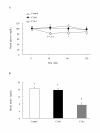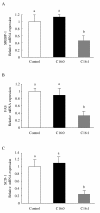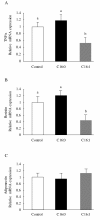Chronic administration of palmitoleic acid reduces insulin resistance and hepatic lipid accumulation in KK-Ay Mice with genetic type 2 diabetes
- PMID: 21774832
- PMCID: PMC3155149
- DOI: 10.1186/1476-511X-10-120
Chronic administration of palmitoleic acid reduces insulin resistance and hepatic lipid accumulation in KK-Ay Mice with genetic type 2 diabetes
Erratum in
-
Correction to: Chronic administration of palmitoleic acid reduces insulin resistance and hepatic lipid accumulation in KK-Ay Mice with genetic type 2 diabetes.Lipids Health Dis. 2021 Aug 24;20(1):90. doi: 10.1186/s12944-021-01513-w. Lipids Health Dis. 2021. PMID: 34429105 Free PMC article. No abstract available.
Abstract
Background: Studies have demonstrated the beneficial effect of palmitoleic acid (C16:1 n-7) on reducing muscle insulin resistance and preventing beta-cell apoptosis. However, the effect of palmitoleic acid on diabetes remains to be elucidated. The aim of this study was to examine the antidiabetic effect of palmitoleic acid in KK-Ay mice, a spontaneous model for studies of obese type 2 diabetes with low insulin sensitivity.
Methods: KK-Ay mice were orally administered vehicle, 300 mg/kg of palmitoleic acid, or 300 mg/kg of palmitic acid (C16:0) on a daily basis for 4 weeks.
Results: Palmitoleic acid reduced body weight increase, ameliorated the development of hyperglycemia and hypertriglyceridemia, and improved insulin sensitivity. In addition, hepatic characteristics were significantly affected, as weight of the liver and hepatic triglyceride levels were lower in the palmitoleic acid group when compared to the control (vehicle and palmitic acid groups). Oil red O staining clearly indicated reduced hepatic lipid accumulation in response to palmitoleic acid. Furthermore, palmitoleic acid down-regulated mRNA expressions of proinflammatory adipocytokine genes (TNFα and resistin) in white adipose tissue and lipogenic genes (SREBP-1, FAS, and SCD-1) in liver.
Conclusions: These results suggest that palmitoleic acid improves hyperglycemia and hypertriglyceridemia by increasing insulin sensitivity, in part owing to suppressing proinflammatory gene expressions and improving hepatic lipid metabolism in diabetic mice.
Figures





References
-
- Misra A, Singhal N, Khurana L. Obesity, the metabolic syndrome, and type 2 diabetes in developing countries: role of dietary fats and oils. J Am Coll Nutr. 2010;29:289S–301S. - PubMed
-
- Maguire LS, O'Sullivan SM, Galvin K, O'Connor TP, O'Brien NM. Fatty acid profile, tocopherol, squalene and phytosterol content of walnuts, almonds, peanuts, hazelnuts and the macadamia nut. Int J Food Sci Nutr. 2004;5:171–178. - PubMed
MeSH terms
Substances
LinkOut - more resources
Full Text Sources
Other Literature Sources
Medical
Research Materials
Miscellaneous

